Discover the Attractions of the UK Canal System
- Pinterest1.7K
- Facebook34
- Twitter7
- Reddit0
- Flipboard1
- Email2
- Buffer36
- 1.8Kshares
- Like
- Digg
- Del
- Tumblr
- VKontakte
- Buffer
- Love This
- Odnoklassniki
- Meneame
- Blogger
- Amazon
- Yahoo Mail
- Gmail
- AOL
- Newsvine
- HackerNews
- Evernote
- MySpace
- Mail.ru
- Viadeo
- Line
- Comments
- Yummly
- SMS
- Viber
- Telegram
- Subscribe
- Skype
- Facebook Messenger
- Kakao
- LiveJournal
- Yammer
- Edgar
- Fintel
- Mix
- Instapaper
- Copy Link
If you travel around the UK, you can’t help but notice the many canals and rivers. There are currently around 3,500 km of navigable waterways criss-crossing the country. Almost all are relics of the Industrial Heritage of the United Kingdom.
What you might not realise is that the UK canals offer a number of extremely interesting attractions to explore. Some are real marvels of early industrial engineering, based on plans by some of Britain’s most famous engineers of the time.

When you travel around the United Kingdom, visit some attractions along the extensive canal system, like the World Heritage listed Pontcysyllte Aqueduct.
Often these sights are conveniently located right next to a main road. Just find a park for your vehicle, walk a few hundreds meters, and you will discover structures of such significance that most are protected by British Heritage.
If the weather is fine, these attractions of the UK canal system provide a welcome break from visiting another picturesque old town, castle, historic house or abbey. On most canals there’s always some action to see – although in calm, slow motion. The canals are home to thousands of colourful leisure boats, cruising through the countryside.
In this post, I will introduce some of the most interesting attractions of the UK canal system to you. Since they are spread all over the country, I have decided to order this updated post by type of structure rather than location. We have personally visited almost all of these sights. Access is free, as these places are on public land.
What you will find in this article:
The Industrial History and Heritage of Canals in Great Britain

Historically canal boats were used for freight. Nowadays you see mostly leisure boats and only the odd open freight boat.
The first canals in Britain were constructed by the Romans, mainly for irrigation, but some were also built to transport goods. They figured that a barge pulled by a horse could carry much more than the horse itself.
But it took until the beginning of the Industrial Revolution for an extensive canal network to be constructed. For a century-and-a-half these canals were the main transport routes to ship coal, iron ore, slate, pottery, and finished iron and steel products. The boats were still towed by horses (as in Roman times), hence the towpath on one side of every canal.
The last canals were financed and constructed in the mid to late 19th century – right when the steam engine was about to wipe out the commercial viability of transport by slow narrowboats along winding canals. Trains quickly took over most haulage of industrial materials and products. Today, you find major train lines right next to canals in quite a lot of places, because they were built by the same private investors that already owned the canal land.
A major disadvantage of canals is that they have to follow the natural contours of the land for most of the way. So they hardly ever take a direct path from A to B. Necessary features like series of locks, aqueducts and tunnels are expensive to build and maintain, and they slow down boat traffic even more. Tunnels and aqueducts are usually one-way traffic only, and all locks are hand operated.
These old structures, most dating from the Victorian period, are now the main attractions of the UK canal system. More about the history of canals in Great Britain on the site of the Canal & River Trust.
Attractive Aqueducts of the UK Canals
Wherever a canal has to cross something there’s the need for an aqueduct. When you’re driving along country roads in the UK you might not notice most of them. They are commonly only short bridges crossing a secondary road and don’t look much different than an old railway bridge on red brick supports. Dripping water or a small puddle might be the only give-away that you are crossing under a waterway aqueduct.
Occasionally aqueducts of a narrowboat canal can cross another canal below, like here the Macclesfield Canal crosses the Trent & Mersey Canal near Kidsgrove.

One canal crossing another canal on an aqueduct, here the Macclesfield Canal crossing the Trent & Mersey canal (difficult to see, below on the left, due to foliage).
But there are also some remarkably large aqueducts dotted around the country. These were real achievements for their time – one of them is now recognised as World Heritage!
The Pontcysyllte Aqueduct

Not the best photo, but this shows the length of the Pontcysyllte Aqueduct, a UNESCO World Heritage Site in Wales.
The Pontcysyllte Aqueduct [roughly pronounced as Pont-ker-sulth-tay] is the only World Heritage listed attraction along the British canal system. There are several reasons that it is such a famous structure.
This aqueduct was conceived in the latter part of the 18th century, by the engineers Thomas Telford and William Jessop, and it was opened for traffic along the Llangollen Canal in 1805. It spans 307 metres, and is over 39 metres at its highest point. This makes it the highest canal or river aqueduct in the world.
The understructure is made from 18 arched stone pillars, which carry a series of cast-iron troughs. It holds 1.5 million litres of water. The ironwork was supplied from the foundries at Shrewsbury and nearby Cefn Mawr.
Please click thumbnails below for a larger photo with description.
- A memorial stone, in Welsh and English, at the Trevor end of the Pontcysyllte Aqueduct.
- The Pontcysyllte Aqueduct, as seen from Trevor.
- Two narrowboats crossing the Pontcysyllte Aqueduct in Wales.
- At the southern end of the Pontcysyllte Aqueduct, looking back towards Trevor. (Hint: you get the best photos of the aqueduct if you stand at the left hand side balustrade in this picture. We moved on because it threatened with rain – we just made it back before drizzle started.)
Along one side there’s a towpath that you can use to walk across this bridge. Although the guardrails are sturdy and reliable, crossing the aqueduct might give some people wobbly legs or other symptoms of vertigo.
Location of the Pontcysyllte Aqueduct: N52.97056, W3.08778
There’s a free parking lot at N52.9725, W3.0855 in Trevor. Motorhomes are allowed to stay over night (more information further down). This site is accessible to people with limited mobility.
Tip for the best photo spot: cross the aqueduct from the parking lot to the far side. Directly where the normal canal starts is a narrow dirt path crossing under the aqueduct to come out on a small viewing platform on the opposite side. This is the only spot to cross the canal on foot for some distance.
The Edstone Aqueduct

The Edstone Aqueduct on the Stratford-Upon-Avon Canal is the longest cast iron aqueduct in England.
If you cannot make it to the Pontcysyllte Aqueduct in Wales, why not visit its smaller relative in England? Although the Edstone Aqueduct is not quite as impressive, it possesses one claim to fame: it’s the longest cast iron aqueduct in England.
Its total length of 145 metres crosses a country road, a railway line and a creek below. And it’s unique, in that the tow path is level with the bottom of the troughs. (At Pontcysyllte Aqueduct your feet are level with the top of the water inside the troughs.)
But best of all: the Edstone Aqueduct is only a short drive [5.5 miles or just under 9 kilometres] from Stratford-Upon-Avon, Shakespeare’s birthplace and a major tourist destination in England. So you can easily combine two very different attractions in one visit.
Location of the Edstone Aqueduct: N52.2464, W1.7641
There’s a small gravel parking lot right below the aqueduct. This site is not easily accessible as you have to get up to the aqueduct via a crooked gravel path with stairs!
The Barton Swing Aqueduct near Manchester

The Barton Swing Aqueduct, photographed from the Barton Swing (Road) Bridge. On the left you see the tall control tower.

The Barton Swing Aqueduct in closed position, with the control tower and the Barton Swing Bridge in the background.
At the outskirts of Manchester you can see the Bridgewater Canal crossing the Manchester Ship Canal on a very unique structure, the Barton Swing Aqueduct. This aqueduct sits on a purpose built island in the middle of the Manchester Ship Canal, which follows the former River Irwell. It replaced an earlier solid masonry aqueduct dating from 1761.
A removable aqueduct became necessary after the Manchester Ship Canal attracted ships too tall to fit under the old, solid aqueduct. The artificial island is the base for two parallel swing bridges, the second being the Barton Swing Bridge, a road bridge. In the middle of the island stands a control tower for both bridges.
The Barton Swing Aqueduct consists of an iron trough supported on riveted wrought iron cross-girders, which are supported on steel twin girders that run along its length. The entire structure weighs over 1,400 tonnes and is 71.6m long and 7.3m wide. The trough itself is 5.5m wide and 2.1m deep.
When tall ships need to pass through the wider canal below, the two bridges are swung open by pivoting 90 degrees on a central round gear base, also located on the island. Before opening, both the canal and the bridge are closed off with large wooden floodgates with rubber edges to contain the water. These are lifted into place by cranes. Originally the central mechanism was powered by a steam engine, then by diesel and nowadays with electricity.

The Barton Swing Aqueduct in the back ground, and the Barton Swing Bridge both swung 90 degrees sideways to open the canal for the Daniel Adamson steam boat to pass. [photo credit ]
This unique swing aqueduct was designed by Sir Edward Leader Williams, an engineer for the Manchester Ship Canal Company. It was was built by Andrew Handyside and Co. of Derby and opened to boat traffic in 1894. Later, Sir Williams was part of the team that built the Anderton Boat Lift (see below).
Location of the Barton Swing Aqueduct: N53.4748, W2.3521
The nearest convenient parking can be found either in Old Barton Road, a dead-end side street along the Manchester Ship Canal, or at the nearby B&Q hardware store. This site is mostly accessible thanks to a paved path.
More canal aqueducts in the UK .
Interesting Boat Lifts on the UK Canals
Canals always have to follow the contour of the land. In a perfect world they would be level from one end to the other. But this is not always achievable in the hilly countryside found in Great Britain. If there’s only a small incline it’s feasible to install a row of locks to get boats from one level to the next. But to navigate, and open and close locks, is a time consuming and physically demanding task.
There are some incredibly long or steep flights of locks in the UK, as I will show you further down. But in many cases it was thought to be more economical to install some kind of mechanical boat lifting device instead. The initial high costs would be quickly recouped by the saving in travelling time for all freight (or at least that was the plan).
Here are 2 of the most remarkable boat lifts in the UK:
The Anderton Boat Lift

The Anderton Boat Lift as seen from the upper level at the Trent and Mersey Canal.
The Anderton Boat Lift is the oldest boat lift in the world, which is still in use. It’s one of only two boat lifts in the UK. It lifts boats from the River Weaver 15.2 metres up to the Trent & Mersey Canal.
In its heyday, the region was a major river transport hub. It was a costly and lengthy exercise to unload river boats and carry all freight up to the canal boats for further transport. After dismissing the idea of installing a series of locks to connect both waterways, this lift was opened in 1875.
After a half hour wait, we were lucky enough to watch two boats using the lift at the same time. One was going up, the other coming down. There’s also a large modern visitor centre with facilities, a snack bar, and some exhibits about the history of the Anderton Boat Lift.
Please click thumbnails below for a larger photo with description.
- The Anderton Boat Lift, as seen from below, the River Weaver.
- The Anderton Boat Lift, as seen from below, with a wide beam tourist boat entering one of the caissons to go up.
- The Anderton Boat Lift: if you look closely you can see two caissons holding boats. The one on the left going up, the one on the right coming down.
- The Anderton Boat Lift: a short(-ish) narrowboat leaving the right-hand caisson.
Location of the Anderton Boat Lift: N53.2728, W2.5305
There’s a large sealed car park above the visitor centre. It’s unfortunately closed for motorhomes over night. This site is accessible and free to visit.
The Falkirk Wheel

The Falkirk Wheel, built in 2002, is a rotating boat lift in central Scotland, connecting the Forth and Clyde Canal with the Union Canal. [Image Credit ]
When commercial canal traffic declined, many of Great Britain’s waterways fell into disrepair. This also happened to a series of locks in Scotland, which connected the Forth & Clyde Canal with the Union Canal – the only connection by water between Glasgow and Edinburgh. Renewed interest by leisure cruisers finally led to the idea of reopening these canals.
But instead of re-constructing the old locks, it was decided to build a modern 21st century structure, the Falkirk Wheel. This is the only rotating boat lift in the world – and quite an impressive structure to see. It has now become the second most popular tourist attraction in Southern Scotland.
There are tourist crafts travelling the canal , with which you can experience going up and down the Falkirk Wheel. When we visited in June 2019 we experienced very Scottish weather and our photos all turned out grey…

A close-up photo of one of the boat trays of the Falkirk Wheel. An identical tray is on the opposite side of the rotating arm. [photo credit ]
Location of the Falkirk Wheel: N56.00028, W3.84167
There are numerous car parks near the Falkirk Wheel, but overnight camping is not permitted. This site is accessible and free.
The Kelpies, Two Stunning Equine Sculptures in Scotland

The enormous Kelpies horse head sculptures in Scotland – photographed in fading daylight with the LED illumination already glowing red.
The aforementioned Falkirk Wheel was only one part of the grand plan to rejuvenate the Scottish Canals. The entire Helix Project , which covers 16 communities in the Falkirk District, also included an extension of the Forth & Clyde Canal to connect it with the River Carron.
Guarding the final lock of this extension are two large equine sculptures, created by Andy Scott and completed in October 2013. These controversial structures, both over 30 metres tall, are made of stainless steel plates on a hollow steel frame. At night they are illuminated from the inside by colour-changing LEDs.
The shape of horses was chosen for several reasons. According to Scottish mythology, Kelpies are shape-shifting water spirits inhabiting the lochs and pools of Scotland. They are said to often appear in the shape of a horse (or the monster of Loch Ness). The artist accepted the shape of a horse also as reference to the “horse’s role in industry and agriculture as well as the obvious association with the canals as tow horses” [quote from WikiPedia ].
More about the mythological Kelpie on Wikipedia.
Location of the Kelpies: N56.0191, W3.7553
This site is accessible with all paved paths.
There’s a paid parking lot within view of the Kelpies. A second parking lot, only a few hundred metres further away near the road entrance, is free all day and open for motorhomes to stay overnight (for a nominal fee).
Some Outstanding Canal Locks of the UK

A canal direction sign (like a road sign) at the junction of the River Severn and the Worcester & Birmingham Canal. It reads: Birmingham 30 miles 58 Locks – so you know you are in for a workout if you take that way.
The most basic structure to make two water levels of different heights navigable for boats is to install a lock or a row of locks. A lock is a chamber with gates at either end. One end blocks off the higher water level, the other end drains into the lower water level.
On British canals you find three basic kinds of locks:
- single locks (uncommon, usually locks come at least in short flights of 3 or more)
- a flight of locks, where one lock comes soon after the next with a small basin (called pound) in between, or
- a staircase lock, where one lock leads directly into another with no pound in between.
I will show you some extraordinary examples of the latter two below.
The Lapworth Locks & The Kingswood Junction
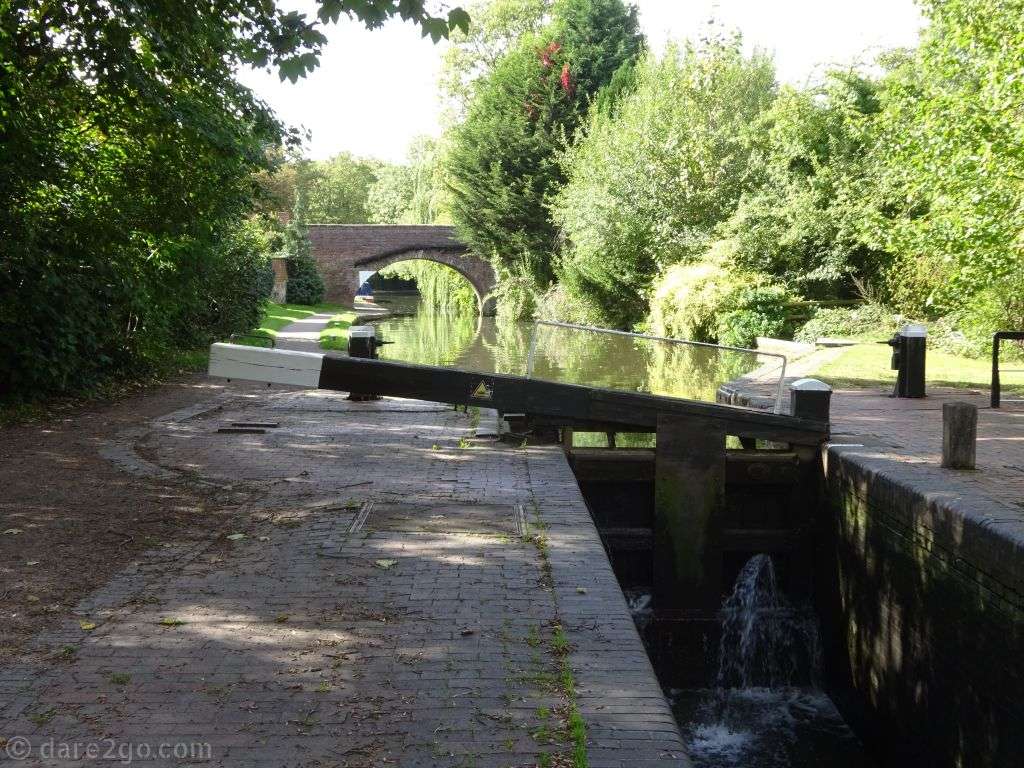
The lower section of the Lapworth Locks, located near the town of the same name in England.
Once you are at the Edstone Aqueduct (mentioned above) it is only around 10 miles (16 kilometres) further to the junction of the South Stratford Canal with the Grand Union at the village of Lapworth. Directly above the Kingswood Junction you will find another attraction of the British Canal system, the Lapworth Locks.
The Lapworth Locks is a long flight of 15 locks located close together along the Stratford-Upon-Avon Canal. The locks mark the division between North and South Stratford Canal. It’s simply fascinating to watch colourful narrowboats navigate them, and admire the physical work that opening and closing the individual lock gates requires. It’s a pleasant stroll, mostly shaded by established trees, going gently uphill. Many park benches invite you to rest, to sit and watch the boaters operating the lock gates.
Most of these locks have large bays below, similar to winding holes, where boats can moor and wait for the ones who travel the locks in the opposite direction. All these locks are very narrow and short, so they only offer enough space for a single narrowboat.

Lock number 13 of the Lapworth Locks. Next to the lock are several narrowboats moored.
Location of Kingswood Junction: N52.3352, W1.7275
This site is accessible as most of the towpath is paved with gentle inclines.
We had no problem finding day parking for our motorhome along Old Warwick Road in Lapworth. Alternatively you can try the car park of “The Boot Inn” pub, which is a bit further up near the locks.
The Bingley Five Rise Locks in Yorkshire

The Bingley Five Rise Locks in Yorkshire. This is the steepest flight of canal locks in England.
The Five Rise Locks is a set of five staircase locks in Bingley. It is the steepest flight of locks in the UK. In staircase locks, the water flows straight from one chamber into the next. This means the lower gate of a chamber releases the water straight into the one below. The five-rise was opened in 1774 and, at the time, was considered a major feat of engineering. Since these locks are so steep, a lock keeper on site operates the locks for the narrowboaters who want to pass through.
If you have read our article about Saltaire , and are inspired to visit the region, Bingley is only a short drive north of Saltaire. There’s a lovely coffee shop right next to the uppermost lock, and always a number of narrowboats moored nearby.
Location of the Bingley Five Rise Locks: N53.8558, W1.8379
Access to this site is rather steep, so people with disabilities might need an assistant.
The only convenient parking is in the residential street above the locks. But there is enough room to park a small(-ish) motorhome.
Neptune’s Staircase in Scotland
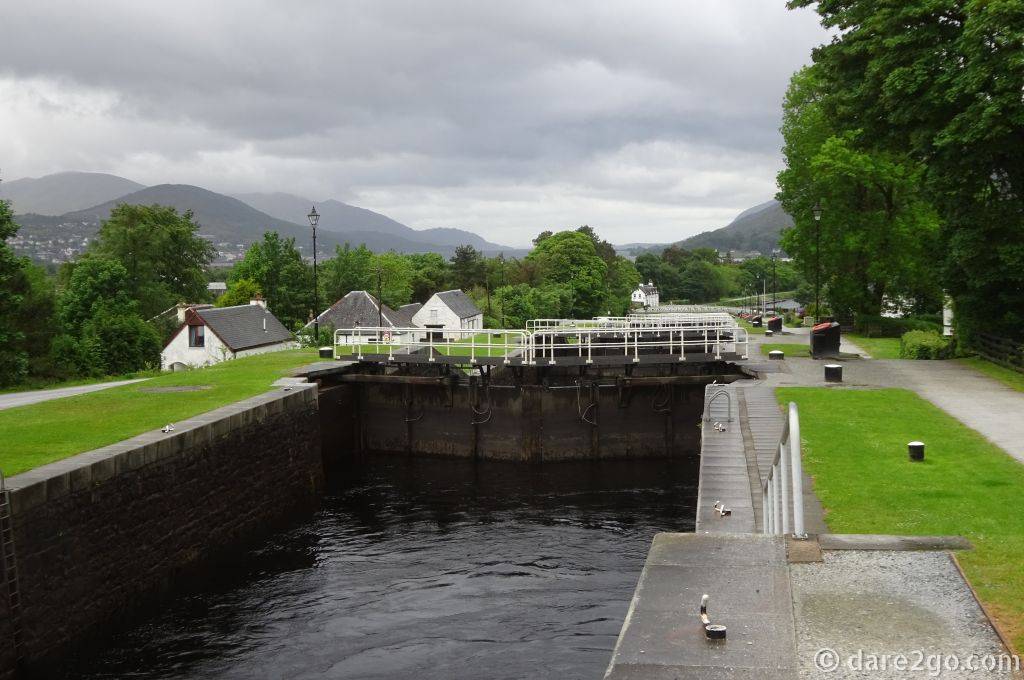
The Neptune’s Staircase Locks looking from the top lock downhill. To the left are a couple of white buildings, which had previously served the canal.
Since we are interested in the British system of canals, Neptune’s Staircase in Scotland was a logical stop, particularly because it was right along our route north. These locks are part of the Caledonian Canal and two facts make them more interesting: they were also built by Thomas Telford (see Pontcysyllte Aqueduct above), between 1803 and 1822, and they are the longest staircase locks in Britain.
Neptune’s Staircase was part of a new shipping route between Glasgow and Inverness. This shipping route then crosses through Loch Ness further north. But the Caledonian Canal was somewhat of a failure on all fronts.
It was initially conceived to stem emigration from the Highlands. The public works were thought to provide employment and the canal to help to develop industry, fishery and agriculture. First of all, the workmanship of the canal was of such poor quality that the locks required extensive repairs several times, or the walls would have collapsed.
The emigration problem had a much deeper cause and couldn’t be stopped by installing a regular shipping line. Around the same period, the large landowners of Scotland had discovered the ease of breeding sheep on their lands. They required more grazing pasture and consequently evicted the established tenant farmers, who had worked their land until then. The shipping line finally went bankrupt by the end of the First World War.
If you look at our photos you will see that these locks are much wider than others. This is because they were designed for much larger ships – not for narrowboats.
Location of the Neptune’s Staircase: N56.846, W5.094, near Fort Williams
This site is accessible, the towpath is fairly wide and mostly tarred.
There is a large gravel parking lot at the bottom of the locks – next to the pub (but public land). You can stay there overnight with a motorhome.
Added bonus: if you’re visiting at the right time (just before 10AM when we were there, but check timetable) the steamtrain, made famous as “Hogwarts Express” in the Harry Potter movies, crosses the bridge right below the bottom lock!
England’s Longest Flight of Locks: the Tardebigge Locks

An aerial view of some of the Tardebigge Locks, with the Tardebigge Engine House in the centre of the photo. [photo credit ]
Anybody who has ever travelled on a narrowboat will know that going through locks can be hard physical work. Each and every gate has to be opened by pushing it with your full body weight, the paddles (to flood or drain the lock) have to be wound up and down manually. It takes around 5-6 hours to navigate this flight of canal locks. And if you are in the middle of a flight of locks you are not allowed to moor, you have to continue – come rain, hail, or shine (and you’ll always encounter one of these in the UK).
Along the Worcester & Birmingham Canal is the longest flight of locks on any canal in the UK – 30 in a row! These are the infamous Tardebigge Locks. The top lock 58 is one of the steepest single locks on any narrowboat canal in England. It was installed after an experimental vertical boat lift, built in 1808, had failed soon after and was too costly to replace. Near lock 57 you find the former Tardebigge Engine House, built to pump water from the Tardebigge Reservoir into the canal to replenish the water level in the locks.
We visited the Tardebigge Locks on one of the truly miserable days in Great Britain and didn’t see much of them. Inside the Queen’s Head Inn felt much more comfortable than being out in driving rain…

A close-up photo of the bottom lock of the Tardebigge Flight of locks. This is less than 2 minutes walk from the Queen’s Head Inn.
I found this video of a drone flight across some of the Tardebigge Locks .
Access to the Tardebigge Locks:
N52.3214, W2.0107 (Lock 58) It might be difficult to find parking nearby and it’s a bit of a walk from lock 58 to 57 and the subsequent flight of locks.
N52.3091, W2.0574 (Queen’s Head Inn at Stoke Pound, bridge #48 on the map below) This is a much more convenient access to the flight of locks. The pub sits right on the edge of the canal and has two large paved parking lots. You have to cross the narrow road bridge to get to the towpath. Then it’s around 200 metres before you reach the bottom lock of the Tardebigge Flight.
These locks are not accessible for people with limited mobility unless they have assistance. There’s a small staircase from the bridge to the towpath and this is rather narrow and bumpy in places.

A map of the Tardebigge Locks. Each arrow shape represents one lock. Stoke Pound Br. 48 is the location of the Queen’s Head Inn Pub.
Final Tips for Visiting the Attractions of the UK Canal System

A total of 29 locks formes the Caen Hill Flight. They cover a rise of 72 m in 3.2 km on the Kennet and Avon Canal. You can find these canal locks in Devizes in Wiltshire, England. [Image Credit ]
As I have shown you, there are quite a few sights along the canal system in Great Britain which are worth a visit. My list is by no means complete: for example, there are also several other famous flights of locks, like the Caen Hill Flight in Wiltshire, England (location N51.35253, W2.02559). All are fascinating attractions to experience some of the industrial heritage of the canals in Great Britain.
We first learned about narrowboats, when Yasha’s sister and her husband bought one, and set off on their own nomadic way in 2014. When we returned to Europe, after our time in South America, we caught up with them as soon as possible. They had visited us in Peru , to get a taste of our life, and now we had the opportunity to get a taste of theirs. Since then, we have returned onto the “Celtic Maid” several times.

Yasha and her sister on the Celtic Maid. You can follow them on their blog Narrowboat Aussies.
There are two kinds of canal boats: a narrowboat, which can travel on all canals, and the less common wide beams, which are twice the width and limited to a select few of the British canals.

Colourful narrowboats moored up along the Bridgewater Canal near Dunham Massey in England.

Compare the width of this canal boat with a narrowboat and you’ll understand why they are called wide beam boats.
Once you step inside a canal boat, you’ll find that it’s not so much different to a motorhome. Narrowboats have a cramped galley kitchen, some seating which converts to a bed, and often a cassette toilet. They also have water tanks, which need to be filled regularly. So canal boats rely on similar services to those you need for your RV. If you can find service points for boats, where you can get in with your camper, you’ll find almost everything you need… Just ask nicely.
Canals and Motorhomes
As I mentioned, the canal network not only makes for interesting stops, it can also provide much needed services for people travelling in a motorhome.
We found this at the Pontcysyllte Aqueduct. Being a tourist attraction, there was enough space to park overnight (and free, which is a lovely exception for the UK), a toilet building with a dedicated room to empty our cassette toilet, and at the wharf across the canal we found a water point to fill our tank. What more could you ask for?
Please click thumbnails below for a larger photo with description.
- We stayed overnight in our motorhome on the quiet parking lot of the Pontcysyllte Aqueduct in Wales.
- Right at the parking lot of the Pontcysyllte Aqueduct is a toilet block with a dedicated room to empty toilet cassettes.
- The next afternoon, before leaving, we asked if we could fill with water at the Anglo Welsh Waterway in Trevor.
- A good description of the Pontcysyllte Aqueduct: a stream in the sky!
But please be respectful: always ask permission, treat the facilities with utmost care, and don’t leave any rubbish behind. Only then will future visitors be able to find the same amenities we have come to value.

A small map, which shows part of the British canal network. Note the light blue lines (easy to miss): these are canals too, just not part of the interconnected net in central England. Link to full-size map .

Graphic showing the principal working of a canal lock – top view and side view.. [photo credit ]
Conclusion
I hope the variety of sights mentioned in this posts has woken some curiosity in you to visit select attractions of the UK canal system! It will be a unique experience and a good reason to stretch your legs and get some fresh air.
Further Reading:
Wikipedia about narrowboats
Wikipedia about the Pontcysyllte Aqueduct
Canal & River trust about the Anderton Boat Lift (with video!)
Wikipedia about the Falkirk Wheel (with video!)
The Instagram page of the Canal & River Trust for further inspiration to visit the canals.
Please share this post on Pinterest to show your friends or to remember for later:



- Pinterest1.7K
- Facebook34
- Twitter7
- Reddit0
- Flipboard1
- Email2
- Buffer36
- 1.8Kshares
- Like
- Digg
- Del
- Tumblr
- VKontakte
- Buffer
- Love This
- Odnoklassniki
- Meneame
- Blogger
- Amazon
- Yahoo Mail
- Gmail
- AOL
- Newsvine
- HackerNews
- Evernote
- MySpace
- Mail.ru
- Viadeo
- Line
- Comments
- Yummly
- SMS
- Viber
- Telegram
- Subscribe
- Skype
- Facebook Messenger
- Kakao
- LiveJournal
- Yammer
- Edgar
- Fintel
- Mix
- Instapaper
- Copy Link




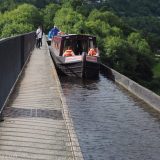
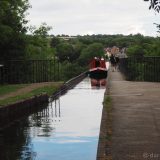



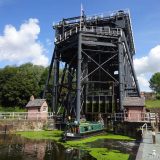
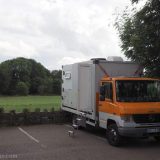

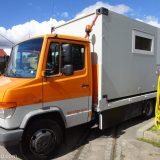















I spent two weeks camping at Foxhangers outside of Devizes, Wiltshire (August 2019) and loved walking along the Avon-Kenet Canal watching the people move through the locks. One woman who had just come through all the locks at Caen Hill Flight in Wiltshire, England said that it took her 2-1/2 hours. Colin Fletcher founded and is still very active in running the business. They build the boats, offer for hire rentals and training, and have a marina.
Thank you for reminding me about all the UK canals. We are returning to the UK next year. I’m now thinking we must make sure we keep our eyes out for canals as we travel. I remember they were so pretty. And now you remind me of all the history. I’d love to take a ride in a long boat – perhaps overnight. And I didn’t realise Scotland has canals as well. Thanks for the travel inspiration & tips. I will pin this post so I can reread it before we travel to the UK.
Yes, but the Scottish canals are not connected to the English system! You either have to hire a boat there or have yours transported to Scotland by truck, an expensive option.
I discover today this page. . . . indeed I had not scrolled enough the page of presentation and I saw only the pages in South America. . . . anyway, I wish you a good trip in Europe and I find that your new truck is very well. . . . we are now in French Guyana at home and the truck is still in Argentina. . . . take care . . . .
Thanks Philippe! Travelling in Europe is certainly a change from South America… Everything is so close. Our Bertita is perfect for England; many roads are closed for trucks over 7,5 tons and almost all roads are very narrow. Our best greetings to Chunny!
I never knew the canal boat crowd was so prevalent in the UK Juergen. I find that so neat. I pictured folks traveling by car around the country, with its great roads and stunning scenery. Good to know we can do the boat thing too when we visit. Slower travel. Pinned and Tweeted.
Ryan
I recently asked my relatives who own a canal boat: there are over 100,000 boats registered on the canals.
Really, that many? Do people all travel in them or live in them like in the Netherlands?
Okay, I had to look it up myself! That’s why my reply has taken so long. And, of course, because we have been at the Willys Meeting.
There are currently around 33,000 canal boats registered in the UK (a figure I found in several sources) and around 26% of these are used as prime residence (according to this article )